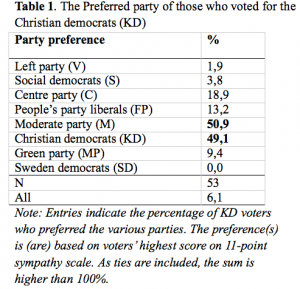By Annika Fredén, Lund University
What is the story?
The concept of strategic voting is well-known in anglo-saxon politics. It refers to the tendency of some voters not to vote for their preferred party if this party has no chance of winning in their district. These strategic voters then happen to cast a vote for their second (or third) preferred party on the basis that this party is viable. In that sense, they increase the probability that their vote will make a difference in the final electoral results.
Strategic voting also exists in continental European democracies where the principle of proportional representation (PR) is applied. In a recent article on the 2010 Swedish general election, I show that many of the supporters of the centre-right Moderate party strategically cast a vote in favour of the Christian democrats. In this entry, I first explain the multi-faced concept of strategic voting in PR systems and I then examine in more details what happened in Sweden during that election.
Strategic voting in PR systems
As mentioned above, the concept of strategic voting, which was originally put forward to understand the choices made by voters in elections held under plurality such as in the US or the UK, is also useful to grasp the reality of elections organized under PR. In PR elections as well many voters prefer not to cast a vote for their preferred party as a way to influence the electoral result. The calculus is however more complex.
Strategic voting under PR relies on the existence, in many continental Europe democracies, of a minimum vote share a party must obtain to be included in the seat allocation process (usually around 4% or 5%). This electoral threshold is made to prevent the explosion of the number of parliamentary parties. All parties falling below the threshold have no seat in parliament. Therefore, supporters of small parties that are unlikely to pass the electoral threshold, may prefer, just as supporters of non-viable parties in plurality democracies, to cast their vote for larger parties.
However, in most PR democracies, the formation of a coalition of parties is often required for a majority of seats in parliament to emerge. After the election, the parties of the largest coalition (in terms of seats) typically take the government office and split the portfolios among themselves. This creates incentives for voters to cast another type of strategic vote. When a party of a coalition is at risk of falling below the electoral threshold, supporters of another party of this coalition might prefer to switch their vote in favor of this endangered party. If the small party does not pass the electoral threshold, the coalition will have fewer seats. In saving the small party, strategic voters then increase the probability for their preferred party enter government. This type of strategic voting, typical of PR systems, is sometimes labeled ‘threshold insurance voting’.
Evidence from 2010 Swedish General Election
The 2010 Swedish general election is a perfect example of threshold insurance voting. The national parliament is elected through a PR system with a 4% electoral threshold. Before the election, party leaders made it clear that there will be two large coalitions: The first was formed by all centre-right parties (the incumbent coalition), and the second was formed by all left opposition parties.
The centre-right coalition consisted of four parties. Among them, the Christian-democratic party was clearly at risk of falling below the electoral threshold (as polls reported). However, in the end, the party made it to the parliament and the centre-right coalition stayed in office. Data from the 2010 Swedish national election study indicate that this would not have been the case without threshold insurance voting. If we look at the link between vote choice and party preferences, we see that a majority of respondents who voted for the Christian democrats were supporters of the largest party of the centre-right coalition, ie. the Moderate party (see Table 1).
Another question of the pre-election survey is useful to demonstrate the existence of threshold insurance voting in the 2010 Swedish general election. Respondents were asked whether it is important for them that a party might not reach the 4% threshold. The results of a multivariate conditional logit model, where controls for party identification and numerous socio-economic variables are added, report that the predicted probability of voting for the Christian democratic party increases by 24 percent when the respondent was concerned about the threshold.
Concluding remarks
Strategic voting does occur in PR election. The 2010 Swedish general election is a perfect example of a specific type of threshold insurance voting. The Christian democrats were saved by supporters of their senior coalition partner. The campaign conducted by the Moderate party probably played a key role in their decision. Their leader, who also is the prime minister, outspokenly encouraged his supporters to vote for the centre-right coalition (and so, implicitly, not only for his party). In Germany, the senior partner of the centre-right coalition (ie., the CDU) did not encourage its supporters to save the liberal party (ie. FDP) that was at risk of falling below the threshold. As a consequence, the FDP did not obtain enough votes and was kicked out of parliament (see a previous blog entry).
Next September, another general election will be held in Sweden. Coalition signals are likely to be different this time, however. The left coalition was dissolved after their defeat in 2010. It will be very interesting to see how voters react to this new context.
For more detailed analyses, see Fredén, Annika (2014). “Threshold Insurance Voting in PR Systems: A Study of Voters’ Strategic Behavior in the 2010 Swedish General Election.” Journal of Elections, Public Opinion and Parties. Published online.

